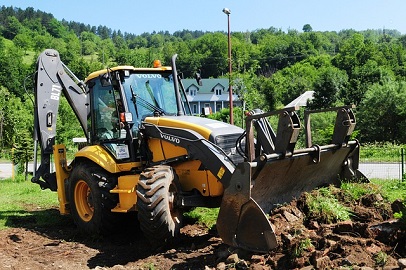Spoil
In the construction industry, the term 'spoil' generally refers to excavated or unwanted material that is removed from the construction site during excavation, earthworks, foundation construction and so on.
Spoil may include soil, rock or other debris that is not useful or necessary for the construction project. It is typically removed from the site and disposed of at a designated facility.
The amount of spoil generated during construction can vary greatly depending on the nature and size of the project, the ground conditions, and the construction methods used. Managing spoil is an important aspect of construction, as improper handling and disposal of spoil can lead to environmental pollution.
In some cases, spoil may be reused or recycled on site, such as by using excavated soil for backfill or landscaping. This can help reduce the amount of material that needs to be disposed of, and may also give cost savings. However, this is not always feasible, in particular in areas where the soil quality is poor or the ground is contaminated.
The amount of spoil generated by the UK construction industry varies from year to year depending on the level of construction activity and the nature of the projects being undertaken. According to data from the UK government's Waste Data Flow report for 2019, the construction, demolition, and excavation sector generated a total of 59.4 million tonnes of waste, of which 29.3 million tonnes was excavated waste, including spoil. The report notes that the majority of excavated waste is disposed of in landfill sites, although some of it is reused or recycled, primarily for land restoration or landscaping purposes.
It's worth noting that the UK construction industry has set targets for reducing waste and improving sustainability, including through the use of more efficient construction methods, reducing the use of virgin materials, and increasing the reuse and recycling of construction waste, including spoil. This reflects a growing awareness of the environmental impact of construction activities and a desire to improve the sustainability of the industry as a whole.
[edit] Related articles on Designing Buildings
Featured articles and news
From studies, to books to a new project, with founder Emma Walshaw.
Types of drawings for building design
Still one of the most popular articles the A-Z of drawings.
Who, or What Does the Building Safety Act Apply To?
From compliance to competence in brief.
The remarkable story of a Highland architect.
Commissioning Responsibilities Framework BG 88/2025
BSRIA guidance on establishing clear roles and responsibilities for commissioning tasks.
An architectural movement to love or hate.
Don’t take British stone for granted
It won’t survive on supplying the heritage sector alone.
The Constructing Excellence Value Toolkit
Driving value-based decision making in construction.
Meet CIOB event in Northern Ireland
Inspiring the next generation of construction talent.
Reasons for using MVHR systems
6 reasons for a whole-house approach to ventilation.
Supplementary Planning Documents, a reminder
As used by the City of London to introduce a Retrofit first policy.
The what, how, why and when of deposit return schemes
Circular economy steps for plastic bottles and cans in England and Northern Ireland draws.
Join forces and share Building Safety knowledge in 2025
Why and how to contribute to the Building Safety Wiki.
Reporting on Payment Practices and Performance Regs
Approved amendment coming into effect 1 March 2025.
A new CIOB TIS on discharging CDM 2015 duties
Practical steps that can be undertaken in the Management of Contractors to discharge the relevant CDM 2015 duties.
Planning for homes by transport hubs
Next steps for infrastructure following the updated NPPF.
























Comments
[edit] To make a comment about this article, or to suggest changes, click 'Add a comment' above. Separate your comments from any existing comments by inserting a horizontal line.